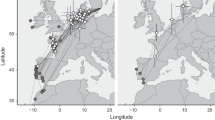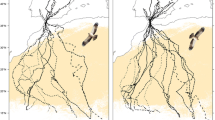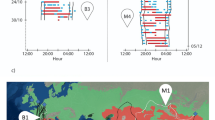Abstract
We used novel Global Positioning System-based satellite telemetry to reconstruct daily time budgets on travelling days of a long-distance migrant, the Osprey Pandion haliaetus, to reveal how landscape affects migratory performance. We compared daily travel routines between the Ospreys’ passage of Europe and the Sahara. In Europe, where feeding habitat is abundant, Ospreys fed both before–after flights and during interruptions, thus, combining migration with foraging. This resulted in a 2.7-h shorter daily flight period in Europe than in the Sahara. A calculated energy budget indicated that a ‘fly-and-forage migration strategy’ is favourable in Europe because associated benefits (energy intake) more than outweigh costs (reduced flight time). The much shorter flight time in Europe was the main explanation why Ospreys covered on average 78 km less distance on a travelling day in Europe than in the Sahara. In addition, there were regional differences in hourly flight speeds that are most probably the result of variation in thermal soaring conditions. We conclude that landscape properties have a profound effect on migration through regional variation in daily routines.


Similar content being viewed by others
References
Alerstam T (1990) Bird migration. Cambridge University Press, Cambridge
Alerstam T (2000) Bird migration performance on the basis of flight mechanics and trigonometry. In: Domenici P, Blake RW (eds) Biomechanics in animal behaviour. BIOS Scientific, Oxford
Alerstam T (2003) Bird migration speed. In: Berthold P, Gwinner E, Sonnenschein E (eds) Avian migration. Springer, Berlin
Alerstam T, Hake M, Kjellén N (2006) Temporal and spatial patterns of repeated migratory journeys by ospreys. Anim Behav 71:555–566
Beck MW (1997) Inference and generality in ecology: current problems and an experimental solution. Oikos 78:265–273
Cochran WW, Wikelski M (2005) Individual migratory tactics of new world Catharus thrushes. In: Greenberg R, Marra PP (eds) Birds of two worlds, the ecology and evolution of migration. The John Hopkins University Press, Baltimore
Farmer AH, Wiens JA (1998) Optimal migration schedules depend on the landscape and the physical environment: a dynamic modeling view. J Avian Biol 29:405–415
Fuller MR, Seegar WS, Schueck LS (1998) Routes and travel rates of migrating Peregrine Falcons Falco peregrinus and Swainson's Hawks Buteo swainsoni in the Western Hemisphere. J Avian Biol 29:433–440
Hake M, Kjellén N, Alerstam T (2001) Satellite tracking of Swedish Ospreys Pandion haliaetus: autumn migration routes and orientation. J Avian Biol 32:47–56
Johnels AG (1969) Naturvetenskapliga museisamlingar—kuriosa eller forskningsobjekt. Fauna och Flora 64:201–206 (in Swedish)
Kerlinger P (1989) Flight strategies of migrating hawks. University of Chicago Press, Chicago
Kerlinger PH, Moore FR (1989) Atmospheric structure and avian migration. In: Power DM (ed) Current Ornithology. vol. 6. Plenum, New York, pp 109–142
Kjellén N, Hake M, Alerstam T (2001) Timing and speed of migration in male, female and juvenile Ospreys Pandion haliaetus between Sweden and Africa as revealed by field observations, radar and satellite tracking. J Avian Biol 32:57–67
Lindström Å (1991) Maximum fat deposition rates in migrating birds. Ornis Scand 22:12–19
Morales JM, Haydon DT, Frair J, Holsinger KE, Fryxell JM (2004) Extracting more out of reallocation data: building movement models as mixtures of random walks. Ecology 85:2436–2445
Ormerod SJ (1989) The influence of weather on the body mass of migrating Swallows Hirundo rustica in south Wales. Ring & Migr 10:65–74
Piersma T (1987) Hop, skip, or jump? Constraints on migration of arctic waders by feeding, fattening, and flight speed. Limosa 60:185–194
Prevost YA (1982) The wintering ecology of ospreys in Senegambia: PhD thesis. University of Edinburgh, Edinburgh
Rubolini D, Pastor AG, Pilastro A, Spina F (2002) Ecological barriers shaping fuel stores in barn swallows Hirundo rustica following the central and western Mediterranean flyways. J Avian Biol 33:15–22
Shamoun-Baranes J, Baharad A, Alpert P, Berthold P, Yom-Tov Y, Dvir Y, Leshem Y (2003) The effect of wind, season and latitude on the migration speed of white storks Ciconia ciconia, along the eastern migration route. J Avian Biol 34:97–104
Strandberg R, Alerstam T (2007) The strategy of fly-and-forage migration, illustrated for the osprey (Pandion haliaetus). Behav Ecol Sociobiol 12:1865–1875
Turchin P (1988) Quantitative analysis of movement: measuring and modeling population redistribution in animals and plants. Sinauer, Sunderland
Wasser JS (1986) The relationship of energetics of falconiform birds to body-mass and climate. Condor 88:57–62
Weber TP, Houston AI, Ens BJ (1994) Optimal departure fat loads and stopover site use in avian migration: an analytical model. Proc R Soc Lond B 258:29–34
Acknowledgements
This research was financed through grants from the Swedish Research Council (to T.A. and to R.K.) and from the Niels Stensen Foundation (to R.K.). We thank René Dekkers and Patrik Olofsson for assistance in the field. We are grateful for support and excellent equipment from Microwave Telemetry Inc. The study was approved by the Ethical Committee in Göteborg (permit to M.H.). We also thank three anonymous reviewers for valuable suggestions and comments.
Author information
Authors and Affiliations
Corresponding author
Additional information
Communicated by W. Wiltschko
Rights and permissions
About this article
Cite this article
Klaassen, R.H.G., Strandberg, R., Hake, M. et al. Flexibility in daily travel routines causes regional variation in bird migration speed. Behav Ecol Sociobiol 62, 1427–1432 (2008). https://doi.org/10.1007/s00265-008-0572-x
Received:
Revised:
Accepted:
Published:
Issue Date:
DOI: https://doi.org/10.1007/s00265-008-0572-x




